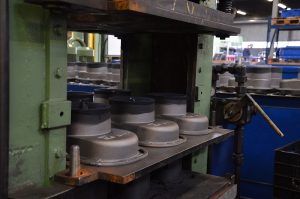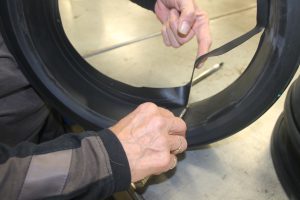Our working method
Our working method is characterized by the personal approach and creating the solution together. As a specialist in the domain of rubber, we are your pre-eminent partner. We are keen on converting your story and requirements into a rubber product, and our services range from design and engineering to the development of associated moulds. Our production is completely customised for each and every product and requirement.
Production process
The manufacturing of moulded rubber products and rubber-metal connections takes place in the Netherlands (Lelystad) and Bulgaria (Kula), where the company’s machine parks house a total of 100 presses. In addition to the pressing facilities, departments for rubber pre-processing, metal pre-processing and product post-processing also form part of the manufacturing process. The moulds that shape the products are designed in Lelystad and thoroughly tested before use.
The first step – Research & Development
Every rubber product we develop always starts at the Research & Devolopment department. Every day we develop and design new rubber products by drawing and calculating a lot with for instance a FEM calculation. An FEM calculation is a predictive software tool that can be used to test the rubber product and to detect possible areas of improvement. In addition, the right type of rubber and possibly other materials are considered for the rubber product. When the design is ready on paper, it will be presented to the customer. If the customer agrees, the mold engineer will start working on the mold.
The second step – producing and testing the mould
A mould gives a rubber product its unique and desired shape. All moulds are designed and tested in Lelystad. Moulds are constructed on the basis of in-house expertise and knowledge of the various rubber compounds, production processes and types of press. When a mould is ready, it is tested by means of sample production. Once the client has given the green light, serial production can begin. To be sure that the new rubber product is resistant to everything, the test phase is execution and crucial.
The third step – rubber pre-processing
Every rubber product is unique in terms of size and composition. The rubber compound is delivered to the factory as a raw material; in most cases in a form that can be used immediately for production. If, however, the rubber needs to be pre-processed, this is carried out in house.
Rubber pre-processing usually means that the rubber must first be blended on a roller until it forms a homogeneous mass. Then, if necessary, it is cut to size using a slicing machine. RIS has the facilities to punch or extrude rubber into the correct depositing form as required. Any scraps can be re-used after kneading on the roller again, so no material goes to waste. Once the rubber has been pre-processed into the required form it can be forwarded to the pressing facility for production purposes.
The fourth step – pressing
The machine park houses two types of press: injection presses for smaller moulded rubber items and compression-mould presses for bulkier and heavier rubber products.
Injection press
When an injection press is used, the rubber is hot-injected directly into a mould. This is especially suitable for a larger production series, because production times are relatively short. An injection press is capable of injecting volume with high precision, which reduces the amount of waste. The products we manufacture on our injection presses can range in size from tens of grammes to a maximum of 20 kg. This frequently involves coloured products, as well as many full-rubber products and rubber-metal connections.
Compression mould press
In a compression mould press, rubber is compressed under high pressure. The mould will already have been fitted into the press, and the rubber is then fed into the press manually for each product. The press then closes, exerting an impressive force of up to 2,000 tons. Due to the combination of heat and the closing force, the rubber is shaped according to the result required. The largest compression-mould press at RIS has a pressing plate surface of 1800 x 1800mm.

The final step – product post-processing
Most moulded rubber products and rubber-metal connections require some post-processing. This mostly manual process is carried out in a dedicated department within the factory. All rubber products are then tested before leaving the factory.

Thanks to the wide diversity of rubber-production presses, RIS is able to produce the required product for all its customers. Working from two locations, RIS is outstandingly flexible and able to make quick deliveries.
RIS is capable of (almost) anything; from just a few pieces to a major production series and from small to very bulky products.
Please feel free to contact us without obligation to discuss the possibilities.

